It’s not uncommon for a single position, especially a remote one, to attract hundreds of applicants. This leaves hiring managers with the difficult task of assessing an overwhelmingly large pool of candidates.
Just how large? We get hundreds of applicants for open roles at Toggl (we’re fully remote and offer flexible hours, so our net is quite wide), but according to recent studies, most corporate jobs get about 250 applications per job posting.
If you’ve ever tried to whittle down a list that size to the top 10%, you’ll know that scheduling multiple interviews is a logistical nightmare. The easiest way to handle that volume? One-way interviews can help a lot.
Asynchronous video interviews allow hiring teams to review candidates on their own time. For candidates, it offers the ultimate convenience: no more scheduling hassles or pre-interview jitters—just record your interview when it suits you best.
TL;DR — Key Takeaways
One-way interviews are time-efficient, standardized, cost-effective, convenient for candidates, and attract a wider talent pool.
Asynchronous video interviews work best as an initial screening tool.
Candidates can best prepare for a video interview process by reading instructions, mentioning specific job responsibilities, and following the STAR method.
As a hiring manager, it’s best to use a one-way video interview to assess candidates’ soft skills, such as communication skills, clarity, and team fit.
Platforms like Toggl Hire, which offers asynchronous interview tools, are popular because they humanize the candidate screening process while helping recruiters optimize their time.
What is a one-way interview?
A one-way interview, or an asynchronous video interview, requires candidates to record their responses to a set of pre-determined questions.
Rather than speaking to a person in a live video interview or in-person interview, you use your computer or smartphone to answer screening questions via a recruitment software tool. Then, a hiring manager reviews the video answers at a later time.
“Isn’t this a bit impersonal?” you might ask. It really depends on where you place an asynchronous interview in your hiring process and other factors, like how many questions you require candidates to answer.
With the influx of remote positions, traditional live interviews are honestly becoming harder and harder to schedule.
One-way interviews eliminate the need for both parties to be present during the screening phase. They also allow recruiters to assess candidates beyond their resume or qualifications and test their soft skills.
This makes asynchronous video interviews best for assessing things like language proficiency, especially for customer-facing remote roles like custom support.
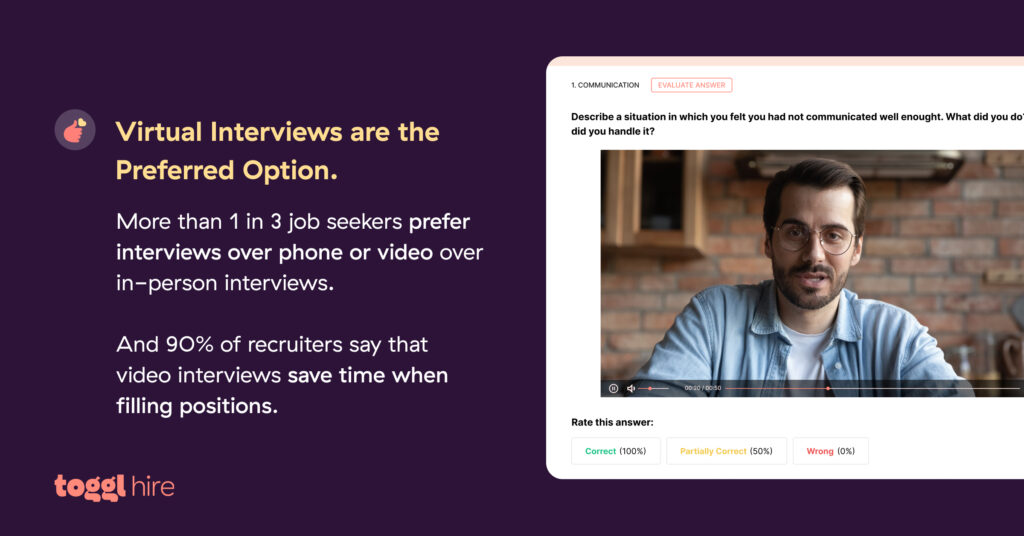
What are the benefits of one-way interviews?
Job seekers and recruiters alike are starting to prefer one-way interviews because they benefit both the interviewer and the interviewee in similar ways.
Time efficiency
Not only do one-way interviews eliminate scheduling conflicts, but these types of interview formats simply take less time. Video interviews are, on average, six times faster than phone interviews.
Rather than delay an interview due to scheduling conflicts, candidates can record at their leisure, and the hiring manager can review at their convenience. This flexibility speeds up the hiring process, making it much more efficient.
Cost-effectiveness
Companies can cut recruitment costs by minimizing any expenses associated with in-person or virtual interviews. Travel expenses are unnecessary, and recruiters don’t have to spend their entire day scheduling and conducting live interviews.
Consistency in evaluation
Standardized formats level the playing field. All candidates are answering the same set of questions under the same conditions, reducing any potential biases. This makes it easier for recruiters to be consistent in the evaluation process.
Broader talent pool
If you’re looking for the most qualified and diverse talent, you may need to look beyond your local area. A one-way interview ensures that applicants aren’t restricted geographically.
This approach not only fits with today’s global work trends but can also give a company a competitive advantage in the market (plus, companies can save up to $10,600 per employee who works remotely, but we digress).
Convenience for candidates
It’s nice when recruitment processes are convenient, but it’s especially important they’re accessible. This format is easier on diverse candidates, specifically those who are neurodivergent or disabled.
Giving candidates the opportunity to present themselves when they feel most prepared and comfortable helps them showcase their best selves.
For hiring managers, it means you can feel more confident you’re selecting the actual best fit for the job, not just someone who performs well in interviews or has an impressively exaggerated resume.
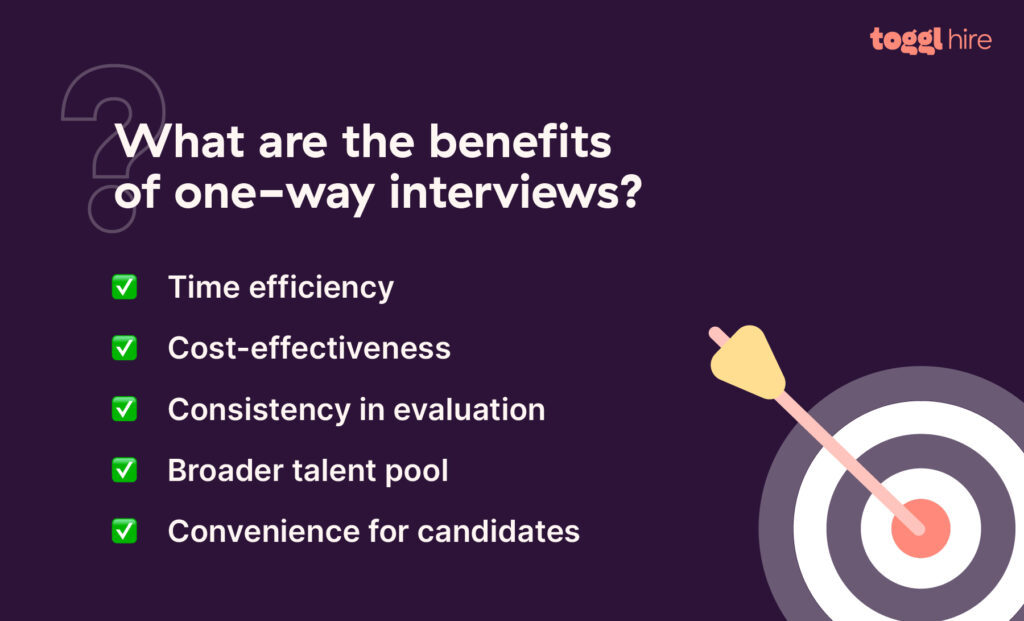
How does a one-way interview work?
While each asynchronous interview software is different, platforms like Toggl Hire allow companies to send instructions to candidates, complete a practice round, and then receive the next steps. Here’s how the process generally works.
1. Setting up
Companies start by compiling a list of questions specific to the job position (you can browse a library of sample questions with Toggl Hire when you create your account).
These are uploaded to the one-way video interview platform. The most engaging asynchronous video interviews will include an introduction video from the company.
Then, send a link to your ideal candidates with detailed instructions on how to access and complete the video interview. Now, sit back, and wait for responses to roll in!
2. Interviewing
Applicants typically start with a practice round to ensure a good internet connection and that their device camera and microphone work.
As part of their interview prep, they can record answers on the platform to calm their nerves and ensure they’re on the right track with their answers. Then, when they’re satisfied, they’ll submit them to the hiring team.
Keep in mind that each platform has different technical aspects. Some have time limits, and others don’t allow job seekers to re-record answers if needed. When comparing platforms to host asynchronous video interviews, think about what’s best for you and the candidates you’ll interview.
3. Reviewing
Once candidates respond, you can evaluate each response and determine who advances to the next round. Offer feedback rather than a generic, automated message to rejected candidates.
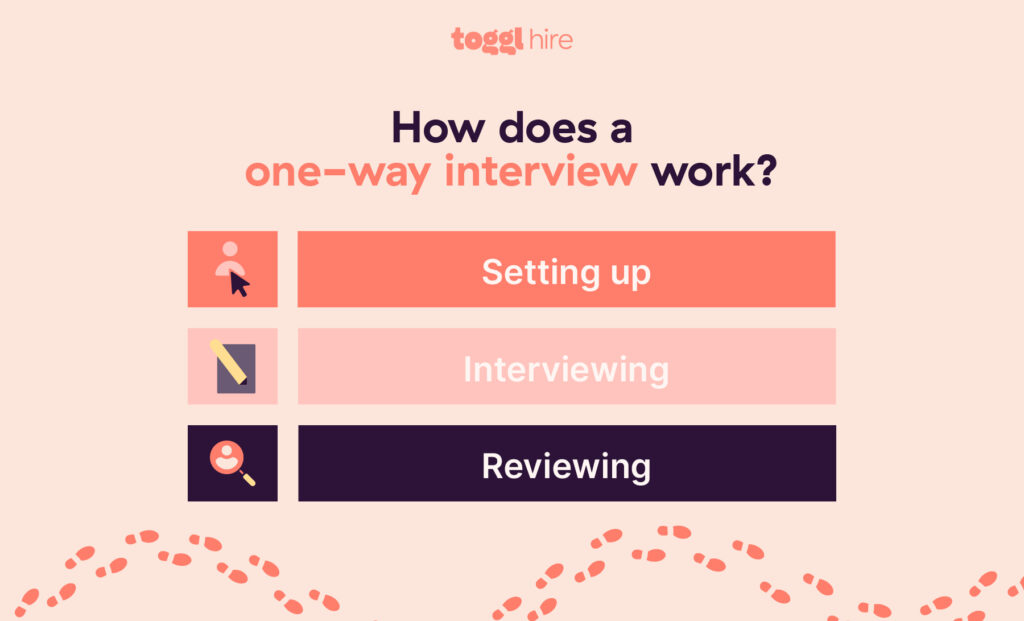
Where do one-way interviews fit in the interview process?
Depending on your hiring procedures, one-way interviews are usually placed towards the beginning or middle of the process.
Making one-way interviews the very first step can feel a little impersonal, though. If set up poorly or right before or after a lengthy skills test, an asynchronous video interview can feel like a tedious assignment.
Placing them too far along the process can also be disheartening for candidates who want to ask their own questions and receive immediate feedback.
That’s why one-way video interviews are best as an initial screening tool, but usually right after some sort of initial interaction with the company.
They give recruiters the chance to pinpoint the most promising candidates early in the process. Once the pool of candidates is narrowed down, they’ll move on to a live interview.
52% of job seekers report declining a job offer because of a poor hiring experience. When done properly, asynchronous video interviewing should improve the hiring experience, not hurt it.
Sample one-way video interview questions and answers
As a hiring manager, your job is a whole lot easier if you tailor questions to the specific role (and the company hiring for it).
This applies to async interviews as much as it does an in-person interview, as it simply makes it easier to identify suitable candidates with relevant experience. It also usually enhances the quality of responses.
A poor set of questions is no excuse for a poor set of responses, though.
If you’re a candidate, you should research the company’s culture, mission, and values. This knowledge allows you to better structure your answers and convey your qualifications. Provide answers that are concise and specific to the position—don’t waste time rambling!
Here are sample questions (and answers) that you might encounter in a one-way interview for a customer service position:
What makes you a good fit for this role? “My five years of experience in managing customer service teams and my proven track record of enhancing customer satisfaction. At XYZ Tech, I led a project that integrated customer feedback into daily operations, resulting in a 20% improvement in service quality.”
Where do you see yourself in five years? “I see myself as a Senior Customer Service Manager or Director, overseeing multiple teams and driving initiatives that improve customer experience on a larger scale. I’m drawn to this role at your company because it offers opportunities for growth in a challenging yet supportive environment.”
What are your greatest strengths? “My ability to communicate complex information to diverse audiences. In my previous job, I often had to present technical data to clients who weren’t very tech-savvy. I developed a strategy to use simplified visuals and analogies, which helped improve client understanding and satisfaction significantly.”
How to ace a video interview as a candidate
Now, candidates, we’re here to help you, too! Ready to ace your one-way interview? Focus on preparation, presentation, and environment. Practice makes perfect, so record beforehand to check your background and re-record (if allowed).
Speak to the position and the company you’re applying to specifically, and make it known why you’re the best fit for the job. Here are a few other pointers (from experience, as most candidates at Toggl have completed asynchronous interviews before) to help you score that next interview.
Read the instructions carefully
Since the upside of a one-way interview is that you get to do it on your terms, you should have plenty of time to review the company’s instructions and answer some practice questions on your own.
It’s important to understand all the technical requirements to avoid any last-minute hiccups with software or hardware. As part of this, pay attention to other information, like the time limit for questions.
Start with a practice session
If the interview platform offers a practice session, take advantage of it! Record yourself on the same device you’ll use for the interview. Make sure your set-up doesn’t have any technical bugs or visual issues. Going through these motions should help you shake off any pre-interview jitters.
If you are using Toggl Hire for your async interview, you can re-record your answers if needed. You can also view your video responses before submitting them. So, take a breath and take it slow and start with a practice session first. You’ll do great!
Check your body language
Body language comes more naturally when you’re speaking to another person. Since you’re doing all the talking in a one-way interview, you’ll need to pay close attention to how you’re presenting yourself.
Make sure you sit up straight, dress professionally, and maintain eye contact with the camera. Simple actions like these convey confidence and professionalism. Avoid fidgeting or erratic hand movements—only use gestures that’d feel natural in a two-way conversation.
Mention responsibilities in the job description
The hiring manager wants to know that you’ve done your homework and thoroughly researched the position. Directly mention certain responsibilities and explain why you’re the ideal candidate to take them on.
Say you’re applying for a marketing position at a beauty company. If one of the interview questions asks you to explain your general marketing plan, you can stand out by making your response fit the specific context of the beauty industry.
Follow the STAR method
The STAR method (situation, task, action, result) is a structured approach for answering behavioral interview questions.
Let’s go back to that marketing position at a beauty company. If one of the questions is, “Describe a time you had to solve a difficult problem,” the candidate could use the STAR method to answer something like this:
Situation: Introduce your story by setting the scene and providing all the context needed.
“In my last role as a marketing lead at a cosmetics company, we launched a new line of mascara that didn’t initially meet sales expectations.”
Task: Explain what your responsibilities were in this situation.
“I was tasked with making up for these lost sales by coming up with a new marketing campaign.”
Action: Detail in a step-by-step manner how you addressed the situation and/or completed the task.
“First, I sought out customer feedback. Then, I launched a targeted social media campaign to better attract our ideal demographic.”
Result: Highlight the positive changes thanks to your actions.
“After this campaign, sales on the new mascara line increased by 30% in two months.”
Re-record if necessary
First impressions are key, but thanks to asynchronous interviews, they can be perfected. If you’re not happy with your first attempt (and the platform allows), re-record your responses.
Listen to your answers and make sure you sound clear and confident before hitting the submit button. If there is a lot of background noise, check your device’s camera and microphone or move to another area and record your answers again.
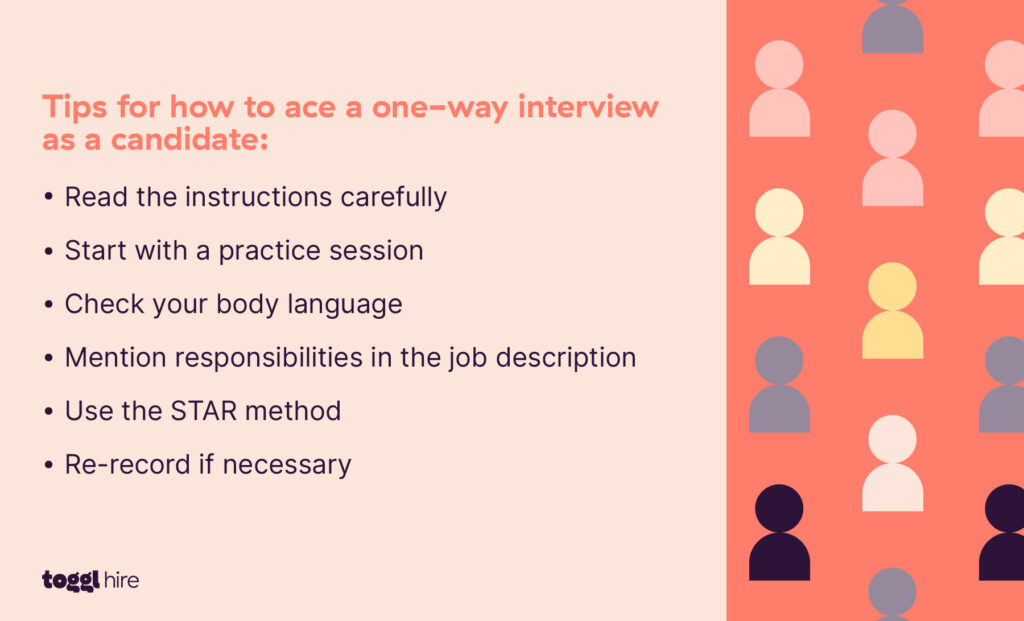
How to assess one-way interviews as a hiring manager
Now, let’s help the hiring managers ace their asynchronous interviews (aka identify the best candidates). To pinpoint your ideal candidate as part of async video interviewing, follow these guidelines:
Look for applicants who offer relevant, concrete examples
Pay attention to responses that are concise and don’t ramble
Consider non-verbal cues like maintaining eye contact and tone of voice
Assess how well the candidate’s professional behavior and answers align with the company’s culture and values
Once you define your criteria, use a standardized rubric to ensure consistent and fair assessments. As you review each asynchronous video interview, assign each candidate a score based on their responses.
Some applicants are turned off from async video interviews because of the lack of feedback and engagement. Use a tool like Toggl Hire to upload a video introducing the company, the culture, and the role.
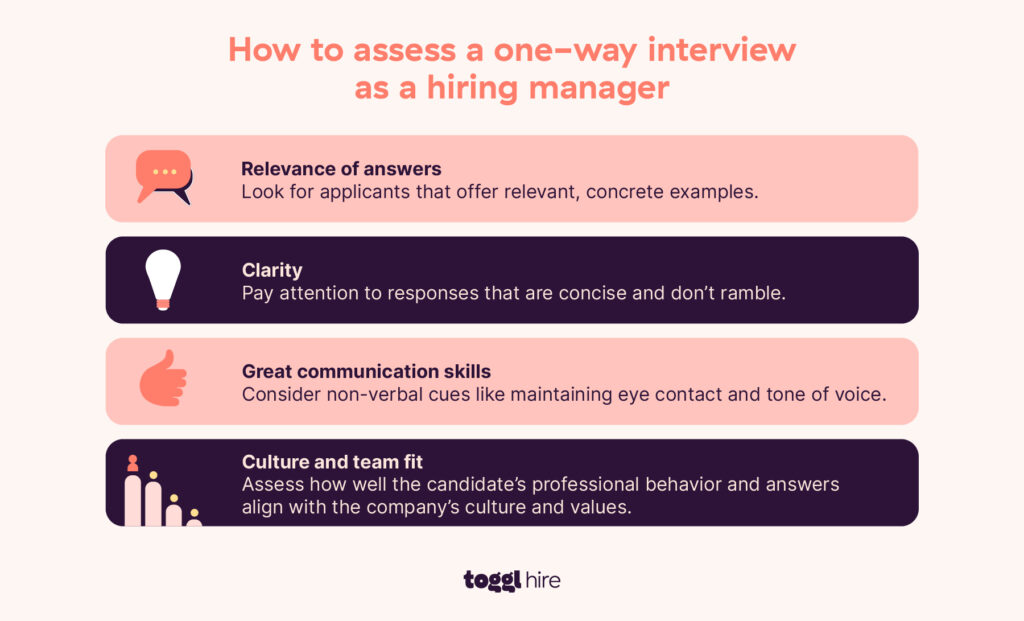
Use pre-recorded video interviews in your hiring process
Ready to set up a hiring process that’s efficient, flexible, and, most important of all, human?
With Toggl Hire, you can do more than watch one-way interview recordings. You can also record a video introduction to the company and the role, giving candidates a solid foundation for their responses.
It’s a win-win for both sides. The best candidates can showcase their skills, making it easy for recruiters to find the right people to interview and hire!
Sign up for a free account to optimize your hiring process with our video interviews and other full-cycle hiring features.
Michelle is an experienced freelance writer who loves applying research and creative storytelling to the content she creates. She writes about B2B SaaS software while also participating in conversations about other industries, such as the digital publishing landscape, sports, and travel.


